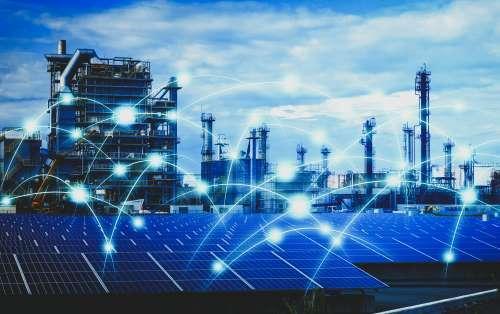How Solar-Powered IoT Sensors Can Improve Infrastructure
The Internet of Things (IoT) has certainly made life easier for the end consumer. But when paired with other well-established technologies like low power smart sensors, solar power, and battery technology, it can also be a vital component to helping civil engineers detect structural problems in aging municipal and national infrastructure before a catastrophic event can occur. Solar technology is the fastest growing renewable energy source on the planet, increasing in worldwide capacity by an average of 40 per cent year-over-year. With so much physical infrastructure being added to the energy grid, having the ability to quickly gather and harness data collected using IoT technology can make it far easier to manage the vast number of panels as well as the energy collected.

Understanding Asset Management Challenges
Solar power has many advantages over traditional energy sources. For one, the source itself is endless, and collecting and delivering solar energy produces very little in the way of emissions (something that can’t be claimed by the fossil fuel industry). With that said, solar energy does pose several challenges for energy companies that are used to having a relatively steady supply of energy to manage. In terms of asset management, solar energy is not the easiest resource to work with, and applying IoT technology will require the installation of end-to-end infrastructure so that data can be collected from source to destination. This includes connecting each solar panel to the utility grid, a monumental effort that also requires all associated cellular modules, gateways, and web platforms are all properly integrated. All of these millions of connections must contain no breaks in connectivity and any vulnerabilities in data securities need to be meticulously anticipated and addressed. It’s easy to see how quickly such an undertaking can become immeasurably complicated.
Another challenge to managing solar or any other renewable resource (whether its solar, wind, or biomass) is having to deal with fluctuations in the energy supply. More often than not, environmental changes can significantly alter energy generation. Those in charge of managing the supply need to be able to quickly adapt to these fluctuations in order to ensure there is no disruption in service. These factors are made all the more complicated by the fact that solar plants tend to be widely distributed and ensuring that each panel is operating efficiently becomes increasingly difficult as the number of panels installed continues to grow. To make matters even worse, the more panels that are installed, the number of potential vulnerabilities will grow exponentially. To mitigate these concerns, an all-in-one edge to cloud IoT solution can be used to connect all of the associated solar assets and minimize security risks.
Simple Integrated Systems are the Future
Now that some of the more glaring challenges have been introduced, let’s dig deeper into how they can be addressed using IoT technology. One of the main advantages of using IoT in this way is that it virtually eliminates significant hardware integration and security concerns while allowing stakeholders to seamlessly access operational information in the cloud and integrate it with existing systems.
When it comes to solar energy infrastructure, IoT allows the user to monitor each and every component of the system from a centralized control panel. When a problem or malfunction occurs, or when a system vulnerability is detected a technician can be sent to address the issue before it can impact other assets within the system.
Even if the energy supply fluctuates with changing environmental conditions, a system that has incorporated IoT monitoring will be better equipped to prevent outages and other productivity issues associated with scheduled and unscheduled downtime.
Practical Applications to Improve Infrastructure
Using this technology to improve the functioning of a power grid is one thing, but using IoT, solar, and low power smart sensors to improve more practical things is another thing entirely. Similarly to monitoring the integrity of the various assets in a power grid, engineers can use these technologies to monitor the physical integrity of aging infrastructure like bridges during atypical environmental conditions and transmit the data back to a centralized hub in real-time. Bridges specifically have been a focus for the deployment of this type of monitoring since the American Road & Transportation Builders Association has reported that nearly 9 per cent of bridges across the United States are structurally deficient. While bridges are vital to transporting goods and services, they also play a key role in evacuating large numbers of citizens during a natural disaster and are crucial to any rescue operations. Having the ability to assess their condition in times of crisis could make a difference in the loss of human life during a cataclysmic event. With enough sensors deployed, civil engineers can be alerted the moment a bridge’s structural integrity passes a threshold and plans can be made to address the issue.
Bridges, of course, represent just one application of this technology. The possibilities, it would seem, are quite vast. A similar deployment of technology can be used to monitor the structural integrity of other vital resources like a city’s water supply. Like water, wastewater management can also be improved by using smart networks to connect infrastructure with control and monitoring systems, such as SCADA (Supervisory Control and Data Acquisition) platforms. As above and below ground infrastructure becomes compromised the embedded sensors can capture and relay that data to city managers and technicians so adequate resources can be allocated to make preemptive repairs. In urban centres, farmers who use rooftops to harvest crops in vertical farms need real-time access to vital agricultural parameters such as evapotranspiration rates, soil moisture saturation, and groundwater conditions. All these applications, and more, are dependent on these types of IoT sensors and those with industrial automation training to ensure they operate effectively.
The growth of low-power smart sensors, the Internet of Things, solar power, and battery technology could help civil engineers detect significant problems within existing municipal and national infrastructure before they become catastrophic. As this technology becomes cheaper and more accessible, the number of real world applications will continue to grow.
